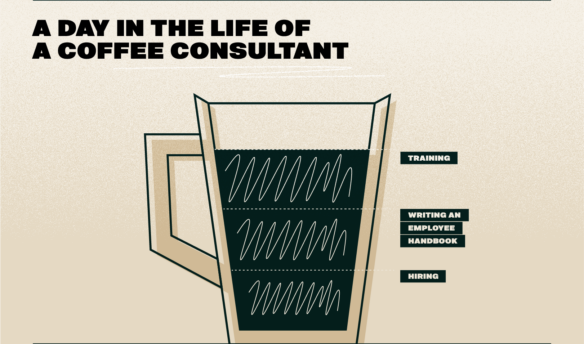[I]n 2005 I stood in front of thirty soldiers, all with more experience than me, and was introduced as their leader. I was barely twenty-one years old, standing in front of a wide range of people of different ages, education levels, and socio-demographic backgrounds. Soon we would jump out of airplanes together, deploy together—and they expected me to lead them through it all. Sound intimidating? It is.
In coffee, taking charge of experienced baristas, roasters, and buyers is equally intimidating. How a team is led can make or break the experience.
In simple terms, leadership means providing direction, guidance, and motivation to succeed in any given mission within an organization. Leaders also influence others to complete tasks. There are hundreds, if not thousands of books on the subject of leadership. It’s been studied using generals, CEOs, average people called to a challenge, and little coffee shops like yours.
Leaders are a part of the team, while bosses assign tasks without any willingness to pitch in.
Good leadership helps businesses run smoothly and efficiently while preventing turnover and loss of property and materials, and increasing customer satisfaction. Cornerstone on Demand, a consulting firm hired to assist with customer retention at one of Rupert Murdoch’s many publications in the UK, made a strong case for investing in building outstanding leaders. In its research, Cornerstone Demand discovered customer retention had nothing to do with customers and everything to do with employees. Happy and productive employees meant happy and continuing subscribers, and the tipping point for satisfied employees was almost always good leadership.
Happy and productive employees aren’t necessarily the result of raises, pats on the back, or free coffee—positioning effective leaders and investing in building your own leadership skills are far more important tactics. According to Cornerstone’s research, an outstanding supervisor was stronger than all other metrics alone, trickling down to positively impact employee performance and customer satisfaction.
But what about pay—doesn’t that play a pretty big role in employee satisfaction? You might be surprised to learn the effects of pay are minuscule. Cornerstone reported a 10 percent pay increase accounted for a 5 percent increase in retention, with the positive effects of pay only increasing employee satisfaction for a matter of weeks.
Salary, comped food, and praise all fall short of the impact of a great supervisor. By looking at trends in leadership and common leadership styles, we’ll explore characteristics of effective leaders. Knowing your tendencies as a manager will help you build a path to more effective mentorship.
Trends in Leadership
Three common themes emerge in research and literature that explore principles of good leadership: leading from the front, leading people instead of things, and only holding employees to the same standards to which you hold yourself.
Lead from the Front
The scene is Mount Everest, near the summit. Sir Edmund Hillary and Tenzing Norgay are finally approaching the peak, a monumental moment in history. And yet, Sir Hillary refuses to have his picture taken at the top, knowing doing so would bring all the attention to him and not the people who made his ascent possible. He assisted with every facet of the trip and after it was over, thanked his team and returned to Nepal often to help the Sherpa community and the mountaineers who would follow in his footsteps. Sir Hillary demonstrated leading from the front, setting an example for those around him through actions instead of words.
Lead People, Not Things
Though some equipment is sleek and shiny, it will not respond to your attempts to lead it (not even to great espresso). In an authoritative role, you’re not leading your café, your roastery, or your warehouse—you’re leading people in these spaces. It’s your responsibility to give your team the ability to master the equipment. Your focus should be leading your employees to feel skilled and confident in their work environment.
Consider the scenario of teaching brew profiles; instead of giving your team a suggested brew profile and walking away, explain why the profile is important, why you take the time to dial in the brew, and encourage them to work to perfect it. Identify members of your team who can mentor newer baristas and collectively usher the team to a place of brew-profile mastery.
Don’t Ask Others to Do What You Would Not
The New York Times ran an article in 2014 titled, “Why You Hate Work.” Many interviewed in the article attributed their hatred for work to bad bosses. These unhappy employees felt bossed instead of led.
Leaders are a part of the team, while bosses assign tasks without any willingness to pitch in. By pitching in to do menial tasks once in a while, hopping on the bar, or taking out the recycling, a leader demonstrates an understanding of every facet of their business, including the chores and daily lives of employees. If you wouldn’t light the roaster’s pilot light with a match every day, don’t ask your employee to do so.
Leadership Styles
Knowing effective leadership strategies is helpful, especially when you understand your style as a leader. There are dozens of primary and hundreds of secondary and hybrid leadership styles. The vast range of styles can be summarized in three main role types: authoritarian, representative, and laissez-faire. Understanding which type of leader you are is an essential step in building skills to better lead your team. A case study for each leadership style shows how different personality attributes have been used in a coffee setting to positively shape a company.

Authoritarian
Authoritarian leaders centralize power and authority in themselves—think a monarch or dictator. There is no question with whom the final say rests. When used properly, this leadership technique is extremely efficient and effective. Conversely, a leader using this style poorly will be perceived as heavy-handed and micromanaging. The key to succeeding with this style is seeking input in making critical decisions.
Case Study—Howard Schultz
In 2008, Starbucks was in a bad place. After an eight-year hiatus from the company, CEO Howard Schultz returned and swiftly took control. In his book, Onward, he talks about turning Starbucks around with an authoritarian role. Schultz made decisions, took action, and changed the trajectory of the company. It’s unique to see an authoritarian leadership style used properly, but he did so by temporarily closing retail stores to allow re-training for employees. Schultz also stopped reporting certain performance criteria to Wall Street, and he made many other critical decisions that would impact the company. Some of those decisions were right, while others were not, but Schultz made his choices and owned them. Most importantly, partners going through the transition were happy the company had a firm leader who considered their input when it came to critical decisions.

Representative
This leadership style can involve group voting, taking input and making decisions, or by picking the best idea out of a group and committing to it. A representative style fails miserably when the leader delegates their authority to the group consensus. As a representative leader, you’ll want to be what the Speaker of the House is to the House of Representatives: take input from everyone, but maintain a clear position as the leader of your party.
Case Study—Flight Coffee Co.
Flight Coffee started as CQ Coffee in Bedford, New Hampshire, a small roasting operation out of a garage with a Diedrich IR-5. Claudia, the owner, gained a solid reputation for quality and expanded while hiring new employees. As the company grew, Claudia realized she needed input from her roaster, barista, and quality control people. She gathered information from each of these representative employees but retained decision-making authority, allowing the employees to feel valued for their input. Claudia changed the name to Flight because, in her words, her leadership style and commitment to quality, company, and employees made her business “take off!”

Laissez-Faire
This leadership style is hands-off, though that doesn’t mean allowing your employees to run free and build their own civilizations Lord of the Flies-style. Laissez-faire leadership can be a disaster if employed the wrong way, but it works extraordinarily well with groups of smart, specialized individuals, such as those at Google or NASA. Roasting operations can benefit from this style, too. Divide your staff into roasters, production team members, and green buyers and quality analysis–quality control. Provide a series of guidelines and let employees operate within a specific set of parameters, while monitoring the team to check on progress. Keeping track of benchmarks also effectively helps employees stay on track.
Case Study—The Roaster Who Shall Not Be Named
In an example of how not to use laissez-faire leadership, a group of roasters and their production staff were left to their own merits within a certain company—let’s call them the Coffee Roasters. Employees of the Coffee Roasters were expected to devise their own schedules, plans, buying system, and production line. Their only directive was to roast coffee and fill orders. Everyone worked hard with little influence from the top, only speaking with their boss to discuss financials. Employees were always blamed for problems within the company, and the Coffee Roasters suffered a 100-percent turnover of its warehouse and roasting staff, resulting in the closure of cafés, a loss of quality, and long-term financial woes. A laid-back leadership style can be good, but an approach that’s too hands-off can produce dire consequences.
Applying these principles and styles won’t happen overnight, and building leadership skills takes time. Still, each improvement will eventually trickle down to all levels of operation if properly set forth with care and diligence.
As a leader, your employees are your responsibility. A strong manager steps back, assesses the work environment and the people in it, and applies the style of leadership that fits best, using strategies to strengthen the team as a whole.
—Andrew Russo is coffee and strategy specialist at Catalyst Coffee Consulting.














